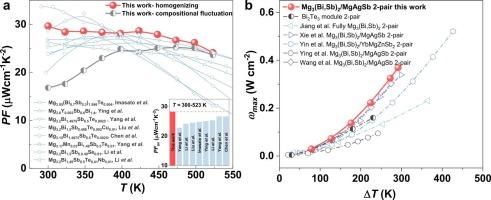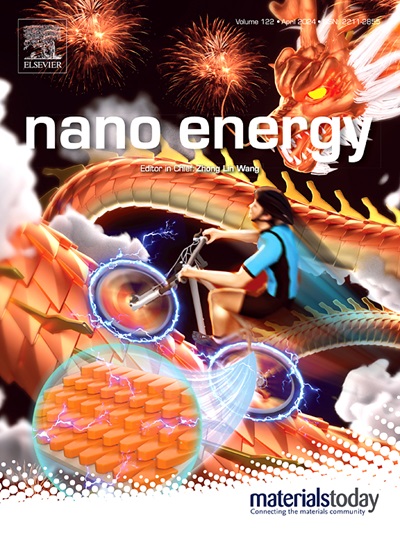Homogenizing composition to achieve high-performance Mg3Bi2-type thermoelectrics
IF 16.8
1区 材料科学
Q1 CHEMISTRY, PHYSICAL
引用次数: 0
Abstract
Introducing compositional fluctuation is an effective strategy for optimizing thermoelectric performance by scattering phonon transport. However, this approach can also impede carrier transport, resulting in an adverse effect, especially in Mg3Bi2-type compounds due to sensitive carrier boundary scattering. This study reveals that homogenizing the composition in Mg3(Bi, Sb)2 from macro- to nano-scale improves both electrical and thermal transport properties. Suppressed compositional fluctuation enhances weighted mobility, resulting in a remarkable average power factor of 28.2 μW cm−1 K−2 (300–523 K) among Bi-rich Mg3(Bi, Sb)2 compounds. Increased carrier concentration from restrained Mg loss mitigates the typical bipolar thermal conductivity effects at high temperatures. Consequently, a room-temperature zT of 0.78 and peak zT of 1.27 are achieved, with an exceptional average zT of 1.09 within the particularly useful 300–523 K temperature range. A two-pair module of Mg3(Bi, Sb)2/MgAgSb shows simultaneously high conversion efficiency of 8.3 % and power density of 0.37 W cm−2 under 294 K temperature difference, validating their potential for low-grade waste heat harvesting. These intriguing results demonstrate an unconventional strategy for enhancing thermoelectric performance via compositional fluctuation control.

求助全文
约1分钟内获得全文
求助全文
来源期刊

Nano Energy
CHEMISTRY, PHYSICAL-NANOSCIENCE & NANOTECHNOLOGY
CiteScore
30.30
自引率
7.40%
发文量
1207
审稿时长
23 days
期刊介绍:
Nano Energy is a multidisciplinary, rapid-publication forum of original peer-reviewed contributions on the science and engineering of nanomaterials and nanodevices used in all forms of energy harvesting, conversion, storage, utilization and policy. Through its mixture of articles, reviews, communications, research news, and information on key developments, Nano Energy provides a comprehensive coverage of this exciting and dynamic field which joins nanoscience and nanotechnology with energy science. The journal is relevant to all those who are interested in nanomaterials solutions to the energy problem.
Nano Energy publishes original experimental and theoretical research on all aspects of energy-related research which utilizes nanomaterials and nanotechnology. Manuscripts of four types are considered: review articles which inform readers of the latest research and advances in energy science; rapid communications which feature exciting research breakthroughs in the field; full-length articles which report comprehensive research developments; and news and opinions which comment on topical issues or express views on the developments in related fields.
 求助内容:
求助内容: 应助结果提醒方式:
应助结果提醒方式:


